
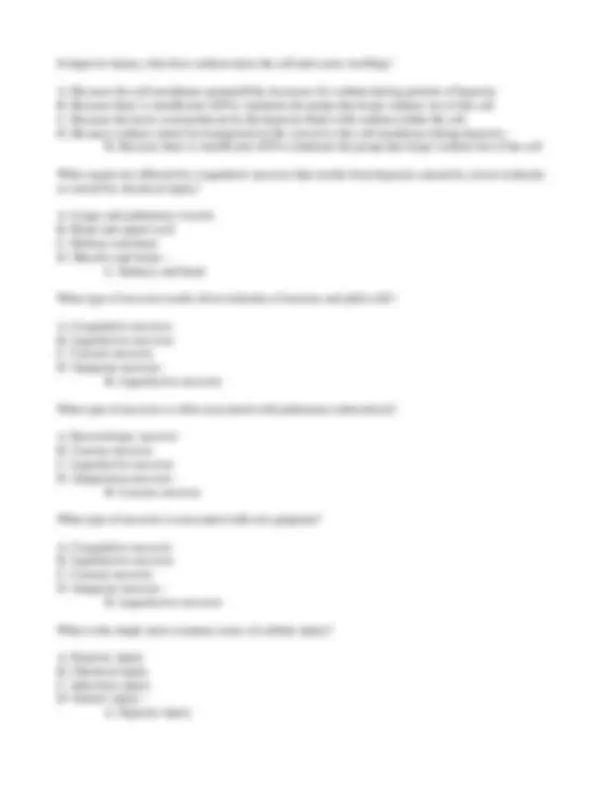
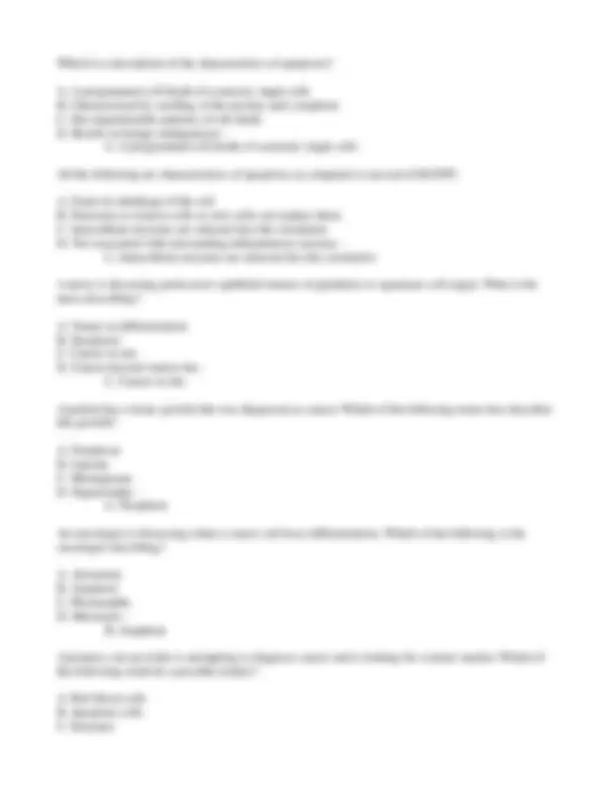
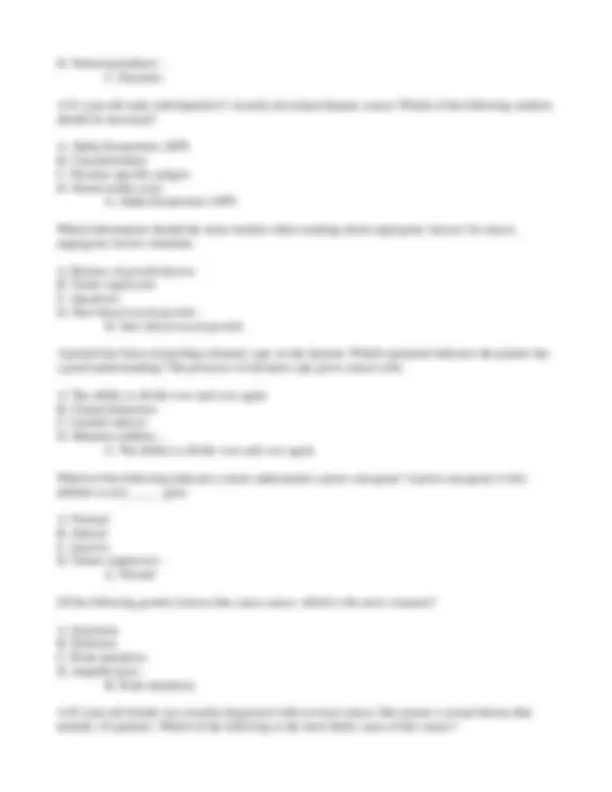
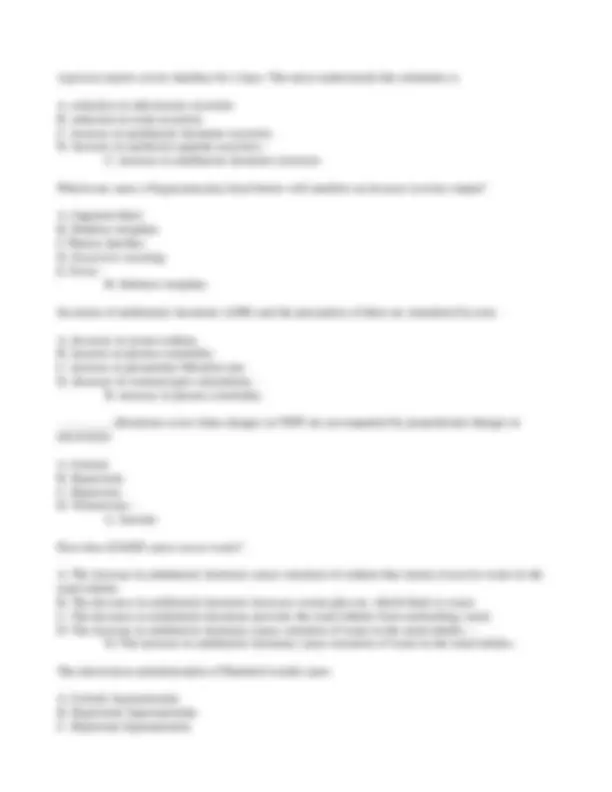
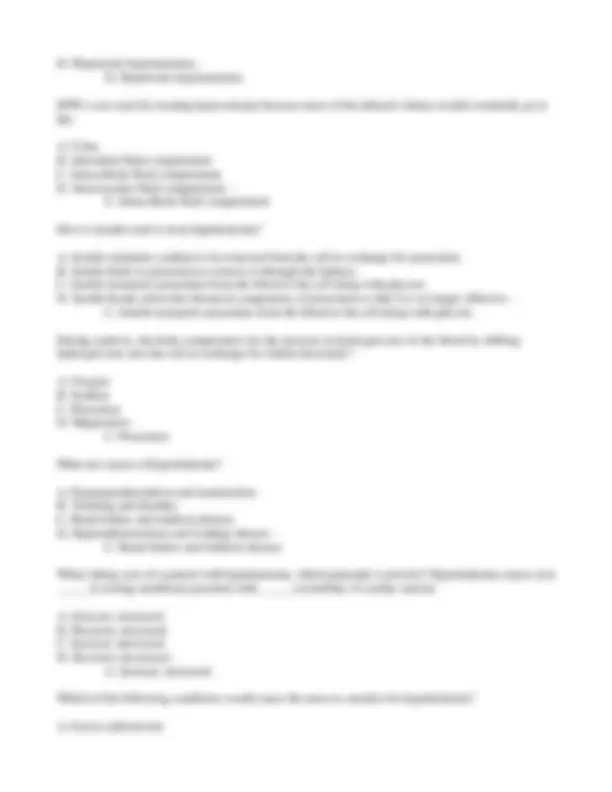
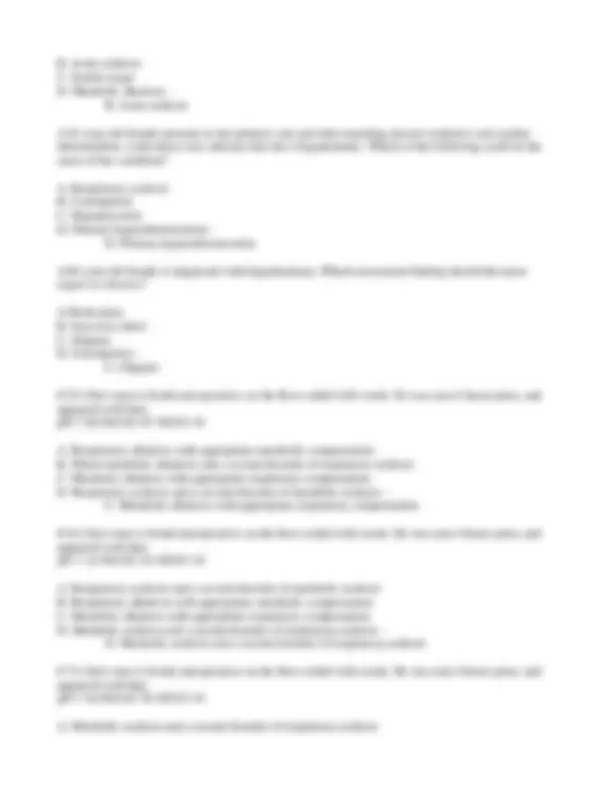
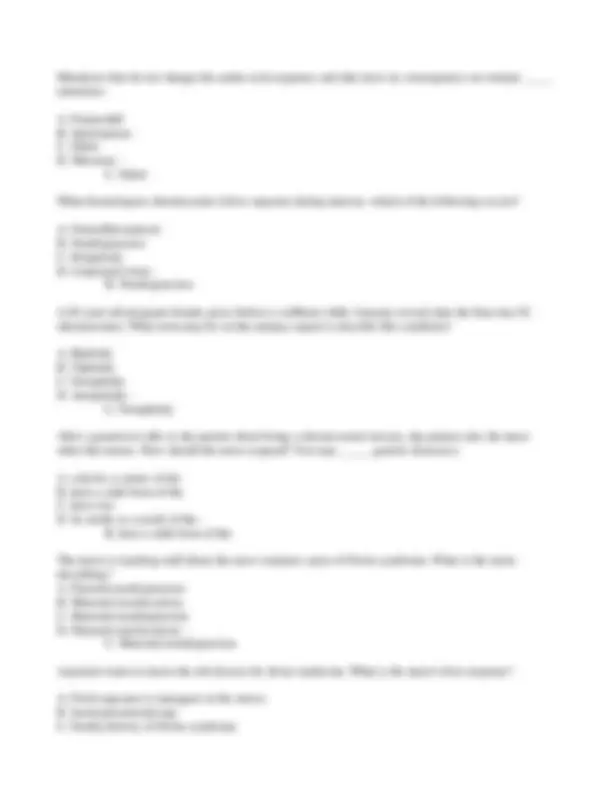
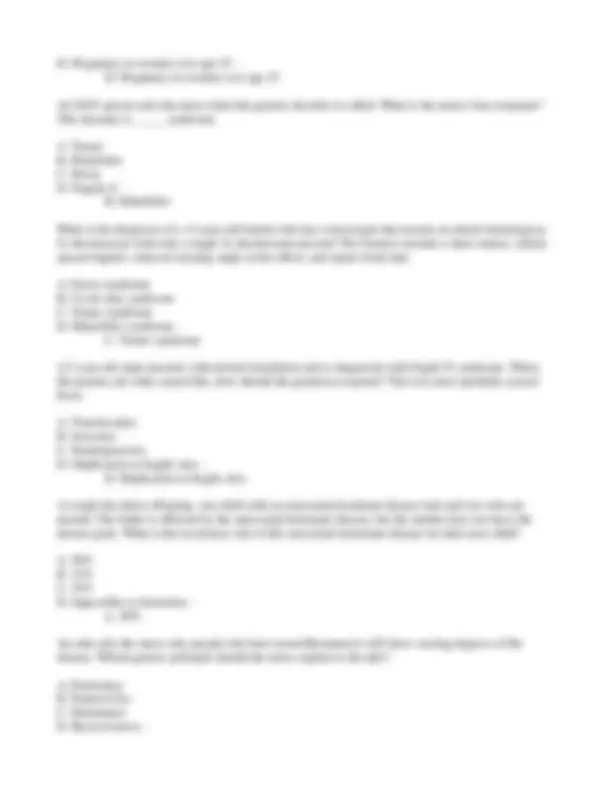
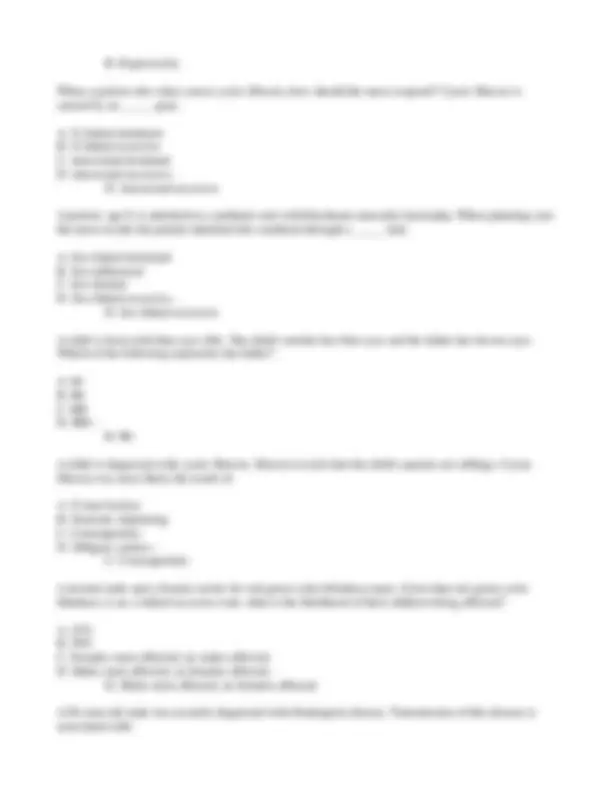


Study with the several resources on Docsity

Earn points by helping other students or get them with a premium plan


Prepare for your exams
Study with the several resources on Docsity

Earn points to download
Earn points by helping other students or get them with a premium plan
Community
Ask the community for help and clear up your study doubts
Discover the best universities in your country according to Docsity users
Free resources
Download our free guides on studying techniques, anxiety management strategies, and thesis advice from Docsity tutors
GNRS515 - Advanced Pathophysiology - Exam #1
Typology: Exams
1 / 16

This page cannot be seen from the preview
Don't miss anything!










T/F: Non-dividing cells, such as myocardial fibers, are capable of hypertrophy, but not hyperplasia. - True T/F: Dysplasia is a common type of normal cellular adaptation. - False T/F: Hypertrophy and hyperplasia rarely occur together. - False T/F: A man with a history of smoking has a bronchial biopsy showing that the normal columnar ciliated epithelial cells have been replaced by stratified squamous epithelial cells. The man is correctly told that this process could be reversed if he quits smoking. - True T/F: Dysplastic changes may be reversible, but more commonly become malignant. - True Which type of cell adaptation occurs when normal columnar ciliated epithelial cells of the bronchial lining have been replaced by stratified squamous epithelial cells? A. Hyperplasia B. Metaplasia C. Dysplasia D. Anaplasia - B. Metaplasia The mammary glands enlarge during pregnancy primarily as a consequence of: A. Compensatory hyperplasia B. Hormonal hyperplasia C. Hormonal anaplasia D. Hormonal dysplasia - B. Hormonal Hyperplasia When the heart's workload increases, what changes occur to the myocardial cells? A. They divide B. They increase in size C. They increase in number D. They undergo metaplasia - B. They increase in size
After ovulation, the uterine endometrial cells divide under the influence of estrogen; this is an example of hormonal: A. Hyperplasia. B. Dysplasia. C. Hypertrophy D. Anaplasia - A. Hyperplasia The abnormal proliferation of cells in response to excessive hormonal stimulation is called: A. Dysplasia. B. Pathologic dysplasia C. Hyperplasia D. Pathologic hyperplasia - D. Pathologic Hyperplasia Removal of part of the liver leads to ______________ of the remaining liver cells. A. Dysplasia B. Metaplasia C. Compensatory hyperplasia D. Compensatory dysplasia - C. Compensatory Hyperplasia During ischemia, what effect does the loss of the adenosine triphosphate (ATP) level have on cells? A. Cells shrink because of the influx of Ca B. Cells shrink because of the influx of KCl C. Cells swell because of the influx of NaCl D. Cells swell because of the influx of NO - C. Cells swell because of the influx of NaCl What is a consequence of plasma membrane damage to the mitochondria? A. Enzymatic digestion halts DNA synthesis. B. Influx of calcium ions halts ATP production C. Reduction in ATP production caused by edema from an influx in sodium D. Shift of potassium out of the mitochondria, which destroys the infrastructure - B. Influx of calcium ions halts ATP production What is a consequence of leakage of lysosomal enzymes during chemical injury? A. Enzymatic digestion of the nucleus and nucleolus occurs, halting DNA synthesis B. Influx of potassium ions into the mitochondria occurs, halting the ATP production C. Edema of the Golgi body occurs, preventing the transport of proteins out of the cell D. Shift of calcium out of the plasma membrane occurs, destroying the cytoskeleton - A. Enzymatic digestion of the nucleus and nucleolus occurs, halting DNA synthesis
Which is a description of the characteristics of apoptosis? A. A programmed cell death of scattered, single cells B. Characterized by swelling of the nucleus and cytoplasm C. Has unpredictable patterns of cell death D. Results in benign malignancies - A. A programmed cell death of scattered, single cells All the following are characteristics of apoptosis as compared to necrosis EXCEPT: A. Starts by shrinkage of the cell B. Functions to remove cells so new cells can replace them C. Intracellular enzymes are released into the circulation D. Not associated with surrounding inflammatory reaction - C. Intracellular enzymes are released into the circulation A nurse is discussing preinvasive epithelial tumors of glandular or squamous cell origin. What is the nurse describing? A. Tumor in differentiation B. Dysplastic C. Cancer in situ D. Cancer beyond (meta) situ - C. Cancer in situ A patient has a tissue growth that was diagnosed as cancer. Which of the following terms best describes this growth? A. Neoplasm B. Lipoma C. Meningioma D. Hypertrophy - A. Neoplasm An oncologist is discussing when a cancer cell loses differentiation. Which of the following is the oncologist describing? A. Autonomy B. Anaplasia C. Pleomorphic D. Metastasis - B. Anaplasia A primary care provider is attempting to diagnose cancer and is looking for a tumor marker. Which of the following could be a possible marker? A. Red blood cells B. Apoptotic cells C. Enzymes
D. Neurotransmitters - C. Enzymes A 52-year-old male with hepatitis C recently developed hepatic cancer. Which of the following markers should be increased? A. Alpha-fetoprotein (AFP) B. Catecholamines C. Prostate-specific antigen D. Homovanillic acid - A. Alpha-fetoprotein (AFP) Which information should the nurse include when teaching about angiogenic factors? In cancer, angiogenic factors stimulate: A. Release of growth factors B. Tumor regression C. Apoptosis D. New blood vessel growth - D. New blood vessel growth A patient has been researching telomere caps on the internet. Which statement indicates the patient has a good understanding? The presence of telomere caps gives cancer cells: A. The ability to divide over and over again B. Clonal distinction C. Limited mitosis D. Mutation abilities - A. The ability to divide over and over again Which of the following indicates a nurse understands a proto-oncogene? A proto-oncogene is best defined as a(n) _____ gene. A. Normal B. Altered C. Inactive D. Tumor-suppressor - A. Normal Of the following genetic lesions that cause cancer, which is the most common? A. Insertions B. Deletions C. Point mutations D. Amplification - B. Point mutations A 45-year-old female was recently diagnosed with cervical cancer. She reports a sexual history that includes 43 partners. Which of the following is the most likely cause of her cancer?
A. Because adipose cells contain little water B. Because the metabolic rate of obese adults is lower than lean adults C. Because the rate of urine output of obese adults is higher than lean adults D. Because their thirst receptors of the hypothalamus do not function effectively - A. Because adipose cells contain little water Water movement between the intracellular fluid compartment and the extracellular compartment is primarily a function of: A. osmotic forces B. plasma oncotic pressure C. antidiuretic hormone D. hydrostatic forces - A. osmotic forces How does the body reestablish equilibrium when solute is added to extracellular fluid making it hypertonic? A. Water is drawn from the extracellular space to the intracellular space B. Sodium is drawn from the extracellular space to the intracellular space C. Sodium is drawn from the intracellular space to the extracellular space D. Water is drawn from the intracellular space to the extracellular space - D. Water is drawn from the intracellular space to the extracellular space Retention of sodium and water is a cause of edema because of an increase in which pressure? A. Capillary hydrostatic pressure B. Interstitial hydrostatic pressure C. Capillary oncotic pressure D. Interstitial oncotic pressure - A. Capillary hydrostatic pressure At the arterial end of capillaries, fluid moves from the intravascular space into the interstitial space because the: A. interstitial hydrostatic pressure is higher than the capillary hydrostatic pressure B. capillary hydrostatic pressure is higher than the capillary oncotic pressure C. interstitial oncotic pressure is higher than the interstitial hydrostatic pressure D. capillary oncotic pressure is lower than the interstitial hydrostatic pressure - B. capillary hydrostatic pressure is higher than the capillary oncotic pressure Low plasma albumin causes edema as a result of a reduction in which pressure? A. Capillary hydrostatic pressure B. Interstitial hydrostatic pressure C. Capillary oncotic pressure D. Interstitial oncotic pressure - C. Capillary oncotic pressure
A person reports severe diarrhea for 2 days. The nurse understands this stimulates a: A. reduction in aldosterone secretion B. reduction in renin secretion C. increase in antidiuretic hormone secretion D. increase in natriuretic peptide secretion - C. increase in antidiuretic hormone secretion Which one cause of hypernatremia listed below will manifest an increase in urine output? A. Impaired thirst B. Diabetes insipidus C.Watery diarrhea D. Excessive sweating E. Fever - B. Diabetes insipidus Secretion of antidiuretic hormone (ADH) and the perception of thirst are stimulated by a(n): A. decrease in serum sodium. B. increase in plasma osmolality. C. increase in glomerular filtration rate. D. decrease in osmoreceptor stimulation. - B. increase in plasma osmolality.
. ________ alterations occur when changes in TBW are accompanied by proportional changes in electrolytes A. Isotonic B. Hypertonic C. Hypotonic D. Normotonic - A. Isotonic How does SIADH cause excess water? A. The increase in antidiuretic hormone causes retention of sodium that retains excessive water in the renal tubules. B. The decrease in antidiuretic hormone increases serum glucose, which binds to water. C. The decrease in antidiuretic hormone prevents the renal tubules from reabsorbing water. D. The increase in antidiuretic hormone causes retention of water in the renal tubules. - D. The increase in antidiuretic hormone causes retention of water in the renal tubules. The intravenous administration of Mannitol would cause: A. Isotonic hyponatremia B. Hypertonic hypernatremia C. Hypotonic hyponatremia
B. Acute acidosis C. Insulin usage D. Metabolic alkalosis - B. Acute acidosis A 42-year-old female presents to her primary care provider reporting muscle weakness and cardiac abnormalities. Laboratory tests indicate that she is hypokalemic. Which of the following could be the cause of her condition? A. Respiratory acidosis B. Constipation C. Hypoglycemia D. Primary hyperaldosteronism - D. Primary hyperaldosteronism A 60-year-old female is diagnosed with hyperkalemia. Which assessment finding should the nurse expect to observe? A.Weak pulse B. Excessive thirst C. Oliguria D. Constipation - C. Oliguria
appeared well then pH 7.50/ PaCO2 47/ HCO3 34 A. Respiratory alkalosis with appropriate metabolic compensation B. Mixed metabolic alkalosis and a second disorder of respiratory acidosis C. Metabolic alkalosis with appropriate respiratory compensation D. Respiratory acidosis and a second disorder of metabolic acidosis - C. Metabolic alkalosis with appropriate respiratory compensation
appeared well then pH 7.12/ PaCO2 32/ HCO3 10 A. Respiratory acidosis and a second disorder of metabolic acidosis B. Respiratory alkalosis with appropriate metabolic compensation C. Metabolic alkalosis with appropriate respiratory compensation D. Metabolic acidosis and a second disorder of respiratory acidosis - D. Metabolic acidosis and a second disorder of respiratory acidosis
appeared well then pH 7.34/ PaCO2 70/ HCO3 34 A. Metabolic acidosis and a second disorder of respiratory acidosis
B. Respiratory acidosis and a second disorder of metabolic alkalosis C. Metabolic alkalosis with appropriate respiratory compensation D. Mixed metabolic alkalosis and a second disorder of respiratory acidosis - B. Respiratory acidosis and a second disorder of metabolic alkalosis pH 7. PaCO2 28 HCO3- 14 Na+ 140 Cl- 116 A. Normal anion gap metabolic alkalosis with appropriate compensation B. Elevated anion gap metabolic acidosis with respiratory alkalosis C. Normal anion gap metabolic acidosis with appropriate respiratory compensation D. Non anion gap respiratory acidosis with metabolic compensation - C. Normal anion gap metabolic acidosis with appropriate respiratory compensation pH 7. PaCO2 24 HCO3- 12 Na+ 128 Cl- 94 A. Non anion gap respiratory acidosis with metabolic compensation B. Elevated anion gap metabolic acidosis with appropriate compensation C. Elevated anion gap metabolic acidosis with a second respiratory acidosis D. Single disorder of respiratory acidosis - B. Elevated anion gap metabolic acidosis with appropriate compensation A 58 y/o man with DM and chronic kidney disease, presents with an abrupt onset of dyspnea 2 hrs ago. pH 7.47 / PaCO2 20 / HCO3- 14 / Na+ 137 / Cl- 113 A. Metabolic alkalosis with a normal anion gap metabolic acidosis B. Respiratory acidosis with appropriate compensation C. Elevated anion gap metabolic acidosis with appropriate compensation D. Respiratory alkalosis with a second disorder of normal anion gap metabolic acidosis - D. Respiratory alkalosis with a second disorder of normal anion gap metabolic acidosis A 48y/o woman is found unconscious next to an empty pill bottle. ABGs: pH 7.09 / PaCO2 34 / HCO3- 11Na+ 135 / Cl- 112 / serum albumin 2. A. Elevated anion gap metabolic acidosis with appropriate compensation B. Elevated anion gap respiratory acidosis with appropriate compensation C. Elevated anion gap metabolic acidosis and respiratory acidosis D. Respiratory alkalosis and a non-anion gap metabolic acidosis - C. Elevated anion gap metabolic acidosis and respiratory acidosis A 61y/o morbidly obese man with COPD and CHF has an ABG and metabolic panel checked during routine pulmonary function tests.
Mutations that do not change the amino acid sequence and thus have no consequence are termed _____ mutations. A. Frameshift B. Spontaneous C. Silent D. Missense - C. Silent When homologous chromosomes fail to separate during meiosis, which of the following occurs? A. Neurofibromatosis B. Nondisjunction C. Polyploidy D. Conjoined twins - B. Nondisjunction A 20-year-old pregnant female gives birth to a stillborn child. Autopsy reveals that the fetus has 92 chromosomes. What term may be on the autopsy report to describe this condition? A. Biploidy B. Triploidy C. Tetraploidy D. Aneuploidy - C. Tetraploidy After a geneticist talks to the patient about being a chromosomal mosaic, the patient asks the nurse what that means. How should the nurse respond? You may _____ genetic disease(s). A. only be a carrier of the B. have a mild form of the C. have two D. be sterile as a result of the - B. have a mild form of the The nurse is teaching staff about the most common cause of Down syndrome. What is the nurse describing? A. Paternal nondisjunction B. Maternal translocations C. Maternal nondisjunction D. Paternal translocations - C. Maternal nondisjunction A patient wants to know the risk factors for down syndrome. What is the nurse's best response? A. Fetal exposure to mutagens in the uterus B. Increased paternal age C. Family history of Down syndrome
D. Pregnancy in women over age 35 - D. Pregnancy in women over age 35 An XXY person asks the nurse what this genetic disorder is called. What is the nurse's best response? This disorder is _____ syndrome. A. Turner B. Klinefelter C. Down D. Fragile X - B. Klinefelter What is the diagnosis of a 13-year-old female who has a karyotype that reveals an absent homologous X chromosome with only a single X chromosome present? Her features include a short stature, widely spaced nipples, reduced carrying angle at the elbow, and sparse body hair. A. Down syndrome B. Cri du chat syndrome C. Turner syndrome D. Klinefelter syndrome - C. Turner syndrome A 5-year-old male presents with mental retardation and is diagnosed with fragile X syndrome. When the parents ask what caused this, how should the geneticist respond? This was most probably caused from: A. Translocation B. Inversion C. Nondisjunction D. Duplication at fragile sites - D. Duplication at fragile sites A couple has three offspring: one child with an autosomal dominant disease trait and two who are normal. The father is affected by the autosomal dominant disease, but the mother does not have the disease gene. What is the recurrence risk of this autosomal dominant disease for their next child? A. 50% B. 33% C. 25% D. Impossible to determine - A. 50% An aide asks the nurse why people who have neurofibromatosis will show varying degrees of the disease. Which genetic principle should the nurse explain to the aide? A. Penetrance B. Expressivity C. Dominance D. Recessiveness -
A. Penetrance B. Recurrence risk C. Expressivity D. Delayed age of onset - D. Delayed age of onset Which of the following disorders is manifested primarily in males? A. Cystic fibrosis B. Neurofibromatosis C. Muscular dystrophy D. Down syndrome - C. Muscular dystrophy